Strain gauges
If a strip of conductive metal is stretched,
it will become skinnier and longer, both changes resulting
in an increase of electrical resistance end-to-end.
Conversely, if a strip of conductive metal is placed under
compressive force (without buckling), it will broaden and
shorten. If these stresses are kept within the elastic limit
of the metal strip (so that the strip does not permanently
deform), the strip can be used as a measuring element for
physical force, the amount of applied force inferred from
measuring its resistance.
Such a device is called a strain gauge.
Strain gauges are frequently used in mechanical engineering
research and development to measure the stresses generated
by machinery. Aircraft component testing is one area of
application, tiny strain-gauge strips glued to structural
members, linkages, and any other critical component of an
airframe to measure stress. Most strain gauges are smaller
than a postage stamp, and they look something like this:
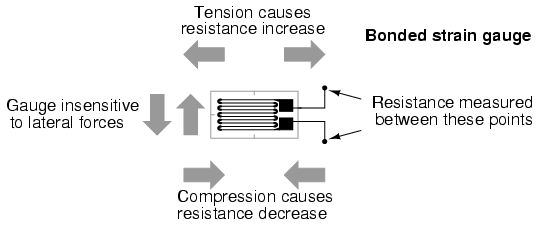
A strain gauge's conductors are very thin:
if made of round wire, about 1/1000 inch in diameter.
Alternatively, strain gauge conductors may be thin strips of
metallic film deposited on a nonconducting substrate
material called the carrier. The latter form of
strain gauge is represented in the previous illustration.
The name "bonded gauge" is given to strain gauges that are
glued to a larger structure under stress (called the test
specimen). The task of bonding strain gauges to test
specimens may appear to be very simple, but it is not.
"Gauging" is a craft in its own right, absolutely essential
for obtaining accurate, stable strain measurements. It is
also possible to use an unmounted gauge wire stretched
between two mechanical points to measure tension, but this
technique has its limitations.
Typical strain gauge resistances range from
30 Ω to 3 kΩ (unstressed). This resistance may change only a
fraction of a percent for the full force range of the gauge,
given the limitations imposed by the elastic limits of the
gauge material and of the test specimen. Forces great enough
to induce greater resistance changes would permanently
deform the test specimen and/or the gauge conductors
themselves, thus ruining the gauge as a measurement device.
Thus, in order to use the strain gauge as a practical
instrument, we must measure extremely small changes in
resistance with high accuracy.
Such demanding precision calls for a bridge
measurement circuit. Unlike the Wheatstone bridge shown in
the last chapter using a null-balance detector and a human
operator to maintain a state of balance, a strain gauge
bridge circuit indicates measured strain by the degree of
imbalance, and uses a precision voltmeter in the center
of the bridge to provide an accurate measurement of that
imbalance:

Typically, the rheostat arm of the bridge (R2
in the diagram) is set at a value equal to the strain gauge
resistance with no force applied. The two ratio arms of the
bridge (R1 and R3) are set equal to
each other. Thus, with no force applied to the strain gauge,
the bridge will be symmetrically balanced and the voltmeter
will indicate zero volts, representing zero force on the
strain gauge. As the strain gauge is either compressed or
tensed, its resistance will decrease or increase,
respectively, thus unbalancing the bridge and producing an
indication at the voltmeter. This arrangement, with a single
element of the bridge changing resistance in response to the
measured variable (mechanical force), is known as a
quarter-bridge circuit.
As the distance between the strain gauge and
the three other resistances in the bridge circuit may be
substantial, wire resistance has a significant impact on the
operation of the circuit. To illustrate the effects of wire
resistance, I'll show the same schematic diagram, but add
two resistor symbols in series with the strain gauge to
represent the wires:
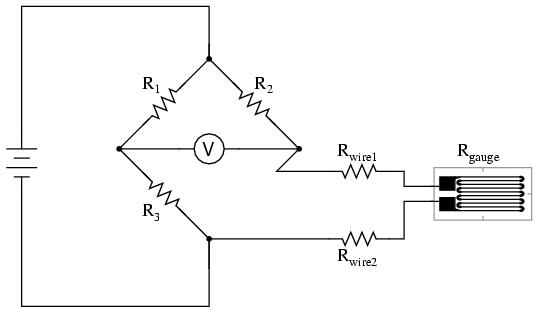
The strain gauge's resistance (Rgauge)
is not the only resistance being measured: the wire
resistances Rwire1 and Rwire2, being
in series with Rgauge, also contribute to the
resistance of the lower half of the rheostat arm of the
bridge, and consequently contribute to the voltmeter's
indication. This, of course, will be falsely interpreted by
the meter as physical strain on the gauge.
While this effect cannot be completely
eliminated in this configuration, it can be minimized with
the addition of a third wire, connecting the right side of
the voltmeter directly to the upper wire of the strain
gauge:
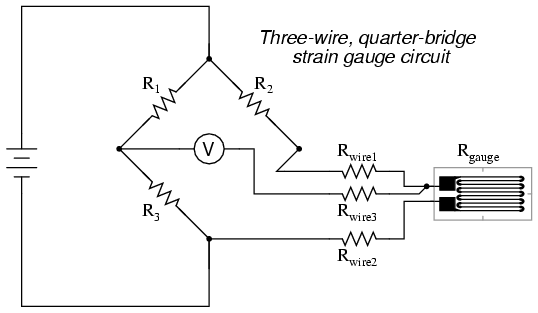
Because the third wire carries practically
no current (due to the voltmeter's extremely high internal
resistance), its resistance will not drop any substantial
amount of voltage. Notice how the resistance of the top wire
(Rwire1) has been "bypassed" now that the
voltmeter connects directly to the top terminal of the
strain gauge, leaving only the lower wire's resistance (Rwire2)
to contribute any stray resistance in series with the gauge.
Not a perfect solution, of course, but twice as good as the
last circuit!
There is a way, however, to reduce wire
resistance error far beyond the method just described, and
also help mitigate another kind of measurement error due to
temperature. An unfortunate characteristic of strain gauges
is that of resistance change with changes in temperature.
This is a property common to all conductors, some more than
others. Thus, our quarter-bridge circuit as shown (either
with two or with three wires connecting the gauge to the
bridge) works as a thermometer just as well as it does a
strain indicator. If all we want to do is measure strain,
this is not good. We can transcend this problem, however, by
using a "dummy" strain gauge in place of R2, so
that both elements of the rheostat arm will change
resistance in the same proportion when temperature changes,
thus canceling the effects of temperature change:
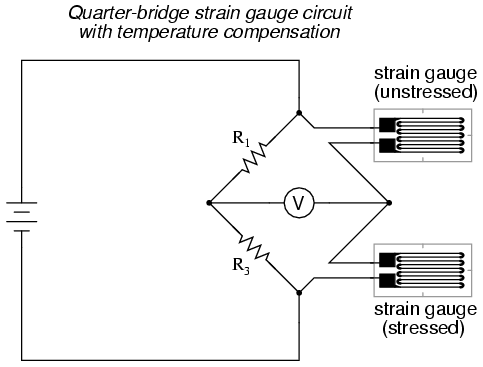
Resistors R1 and R3
are of equal resistance value, and the strain gauges are
identical to one another. With no applied force, the bridge
should be in a perfectly balanced condition and the
voltmeter should register 0 volts. Both gauges are bonded to
the same test specimen, but only one is placed in a position
and orientation so as to be exposed to physical strain (the
active gauge). The other gauge is isolated from all
mechanical stress, and acts merely as a temperature
compensation device (the "dummy" gauge). If the
temperature changes, both gauge resistances will change by
the same percentage, and the bridge's state of balance will
remain unaffected. Only a differential resistance
(difference of resistance between the two strain gauges)
produced by physical force on the test specimen can alter
the balance of the bridge.
Wire resistance doesn't impact the accuracy
of the circuit as much as before, because the wires
connecting both strain gauges to the bridge are
approximately equal length. Therefore, the upper and lower
sections of the bridge's rheostat arm contain approximately
the same amount of stray resistance, and their effects tend
to cancel:
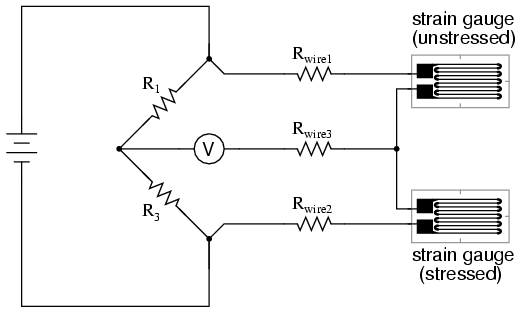
Even though there are now two strain gauges
in the bridge circuit, only one is responsive to mechanical
strain, and thus we would still refer to this arrangement as
a quarter-bridge. However, if we were to take the
upper strain gauge and position it so that it is exposed to
the opposite force as the lower gauge (i.e. when the upper
gauge is compressed, the lower gauge will be stretched, and
visa-versa), we will have both gauges responding to
strain, and the bridge will be more responsive to applied
force. This utilization is known as a half-bridge.
Since both strain gauges will either increase or decrease
resistance by the same proportion in response to changes in
temperature, the effects of temperature change remain
canceled and the circuit will suffer minimal
temperature-induced measurement error:
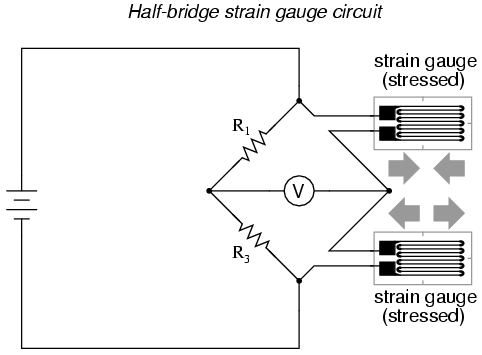
An example of how a pair of strain gauges
may be bonded to a test specimen so as to yield this effect
is illustrated here:
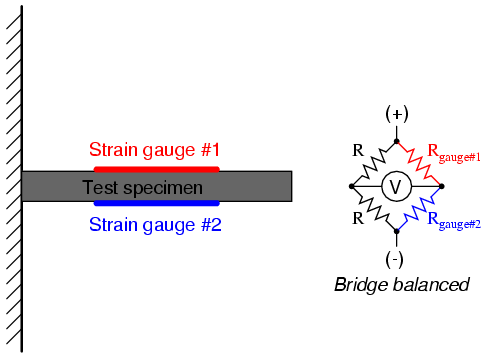
With no force applied to the test specimen,
both strain gauges have equal resistance and the bridge
circuit is balanced. However, when a downward force is
applied to the free end of the specimen, it will bend
downward, stretching gauge #1 and compressing gauge #2 at
the same time:
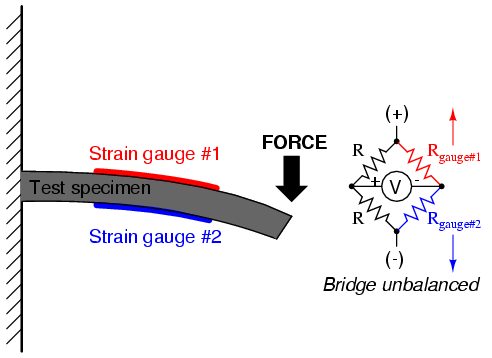
In applications where such complementary
pairs of strain gauges can be bonded to the test specimen,
it may be advantageous to make all four elements of the
bridge "active" for even greater sensitivity. This is called
a full-bridge circuit:
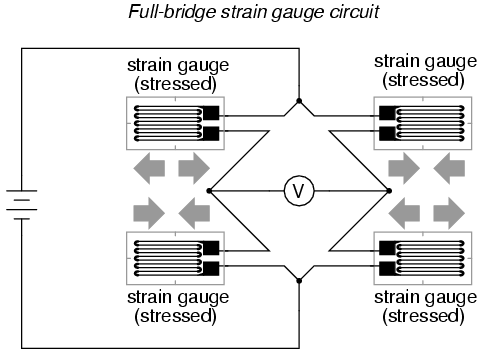
Both half-bridge and full-bridge
configurations grant greater sensitivity over the
quarter-bridge circuit, but often it is not possible to bond
complementary pairs of strain gauges to the test specimen.
Thus, the quarter-bridge circuit is frequently used in
strain measurement systems.
When possible, the full-bridge configuration
is the best to use. This is true not only because it is more
sensitive than the others, but because it is linear
while the others are not. Quarter-bridge and half-bridge
circuits provide an output (imbalance) signal that is only
approximately proportional to applied strain gauge
force. Linearity, or proportionality, of these bridge
circuits is best when the amount of resistance change due to
applied force is very small compared to the nominal
resistance of the gauge(s). With a full-bridge, however, the
output voltage is directly proportional to applied force,
with no approximation (provided that the change in
resistance caused by the applied force is equal for all four
strain gauges!).
Unlike the Wheatstone and Kelvin bridges,
which provide measurement at a condition of perfect balance
and therefore function irrespective of source voltage, the
amount of source (or "excitation") voltage matters in an
unbalanced bridge like this. Therefore, strain gauge bridges
are rated in millivolts of imbalance produced per
volt of excitation, per unit measure of force. A
typical example for a strain gauge of the type used for
measuring force in industrial environments is 15 mV/V at
1000 pounds. That is, at exactly 1000 pounds applied force
(either compressive or tensile), the bridge will be
unbalanced by 15 millivolts for every volt of excitation
voltage. Again, such a figure is precise if the bridge
circuit is full-active (four active strain gauges, one in
each arm of the bridge), but only approximate for
half-bridge and quarter-bridge arrangements.
Strain gauges may be purchased as complete
units, with both strain gauge elements and bridge resistors
in one housing, sealed and encapsulated for protection from
the elements, and equipped with mechanical fastening points
for attachment to a machine or structure. Such a package is
typically called a load cell.
Like many of the other topics addressed in
this chapter, strain gauge systems can become quite complex,
and a full dissertation on strain gauges would be beyond the
scope of this book.
-
REVIEW:
-
A strain gauge is a thin strip of metal
designed to measure mechanical load by changing resistance
when stressed (stretched or compressed within its elastic
limit).
-
Strain gauge resistance changes are
typically measured in a bridge circuit, to allow for
precise measurement of the small resistance changes, and
to provide compensation for resistance variations due to
temperature
|